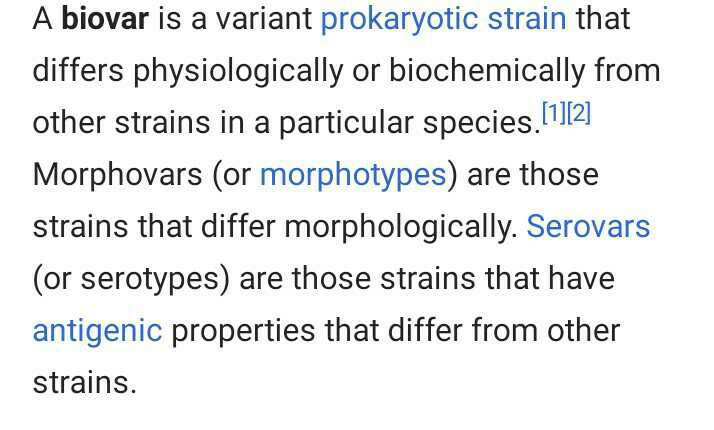Class 11 Exam > Class 11 Questions > What are biovars and give examples ?
Start Learning for Free
What are biovars and give examples ?
Community Answer
What are biovars and give examples ?
What are Biovars?
Biovars are subgroups within a species that possess distinct biological characteristics. These variations can be based on differences in biochemical, physiological, or morphological traits. Biovars are important in distinguishing strains of bacteria or other organisms that may have different pathogenicity, antibiotic resistance, or ecological characteristics.
Examples of Biovars
- **Escherichia coli**: E. coli is a species of bacteria that can be classified into various biovars based on different biochemical characteristics. For example, biovar 1 of E. coli is known for its ability to ferment lactose, while biovar 2 cannot.
- **Mycobacterium tuberculosis**: Different strains of M. tuberculosis can be categorized into biovars based on their resistance to antibiotics. For example, biovar 1 of M. tuberculosis may be resistant to certain antibiotics, while biovar 2 may not.
- **Salmonella enterica**: Salmonella strains can be differentiated into biovars based on their ability to ferment certain sugars. For instance, some biovars of S. enterica may be able to ferment xylose, while others cannot.
Importance of Biovars
Understanding biovars is crucial in fields such as microbiology, epidemiology, and medicine. It helps in identifying different strains of pathogens, predicting their behavior, and developing targeted treatments. By studying biovars, researchers can better comprehend the diversity within species and improve disease management strategies.
Biovars are subgroups within a species that possess distinct biological characteristics. These variations can be based on differences in biochemical, physiological, or morphological traits. Biovars are important in distinguishing strains of bacteria or other organisms that may have different pathogenicity, antibiotic resistance, or ecological characteristics.
Examples of Biovars
- **Escherichia coli**: E. coli is a species of bacteria that can be classified into various biovars based on different biochemical characteristics. For example, biovar 1 of E. coli is known for its ability to ferment lactose, while biovar 2 cannot.
- **Mycobacterium tuberculosis**: Different strains of M. tuberculosis can be categorized into biovars based on their resistance to antibiotics. For example, biovar 1 of M. tuberculosis may be resistant to certain antibiotics, while biovar 2 may not.
- **Salmonella enterica**: Salmonella strains can be differentiated into biovars based on their ability to ferment certain sugars. For instance, some biovars of S. enterica may be able to ferment xylose, while others cannot.
Importance of Biovars
Understanding biovars is crucial in fields such as microbiology, epidemiology, and medicine. It helps in identifying different strains of pathogens, predicting their behavior, and developing targeted treatments. By studying biovars, researchers can better comprehend the diversity within species and improve disease management strategies.
Attention Class 11 Students!
To make sure you are not studying endlessly, EduRev has designed Class 11 study material, with Structured Courses, Videos, & Test Series. Plus get personalized analysis, doubt solving and improvement plans to achieve a great score in Class 11.

|
Explore Courses for Class 11 exam
|

|
Similar Class 11 Doubts
What are biovars and give examples ?
Question Description
What are biovars and give examples ? for Class 11 2024 is part of Class 11 preparation. The Question and answers have been prepared according to the Class 11 exam syllabus. Information about What are biovars and give examples ? covers all topics & solutions for Class 11 2024 Exam. Find important definitions, questions, meanings, examples, exercises and tests below for What are biovars and give examples ?.
What are biovars and give examples ? for Class 11 2024 is part of Class 11 preparation. The Question and answers have been prepared according to the Class 11 exam syllabus. Information about What are biovars and give examples ? covers all topics & solutions for Class 11 2024 Exam. Find important definitions, questions, meanings, examples, exercises and tests below for What are biovars and give examples ?.
Solutions for What are biovars and give examples ? in English & in Hindi are available as part of our courses for Class 11.
Download more important topics, notes, lectures and mock test series for Class 11 Exam by signing up for free.
Here you can find the meaning of What are biovars and give examples ? defined & explained in the simplest way possible. Besides giving the explanation of
What are biovars and give examples ?, a detailed solution for What are biovars and give examples ? has been provided alongside types of What are biovars and give examples ? theory, EduRev gives you an
ample number of questions to practice What are biovars and give examples ? tests, examples and also practice Class 11 tests.

|
Explore Courses for Class 11 exam
|

|
Suggested Free Tests
Signup for Free!
Signup to see your scores go up within 7 days! Learn & Practice with 1000+ FREE Notes, Videos & Tests.


























